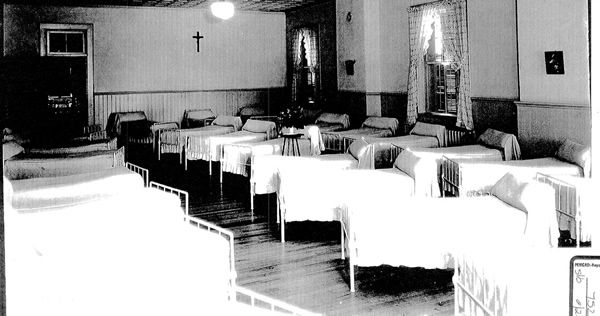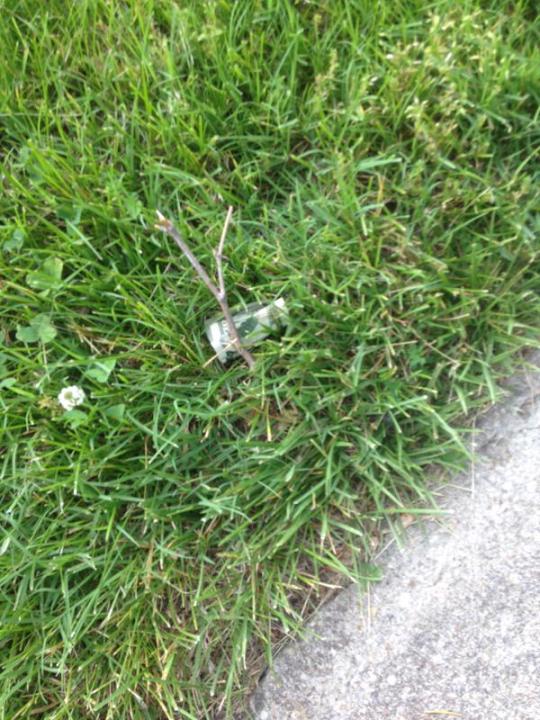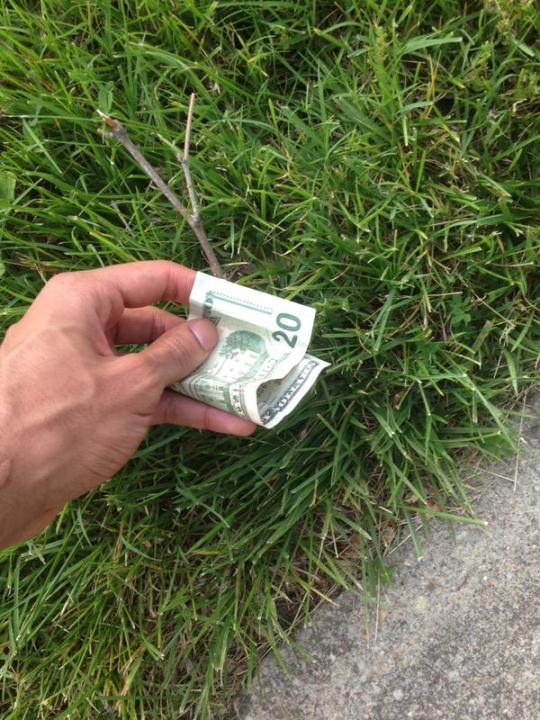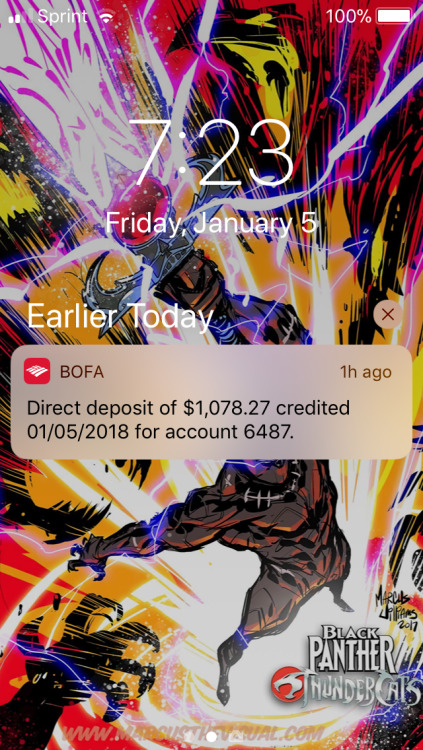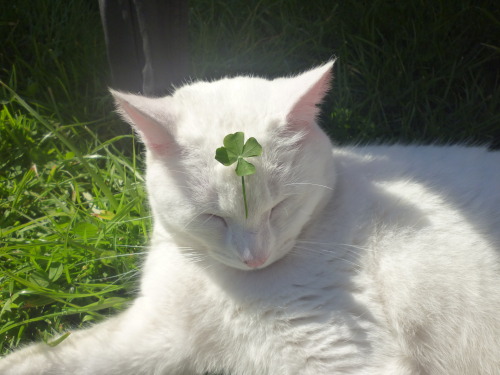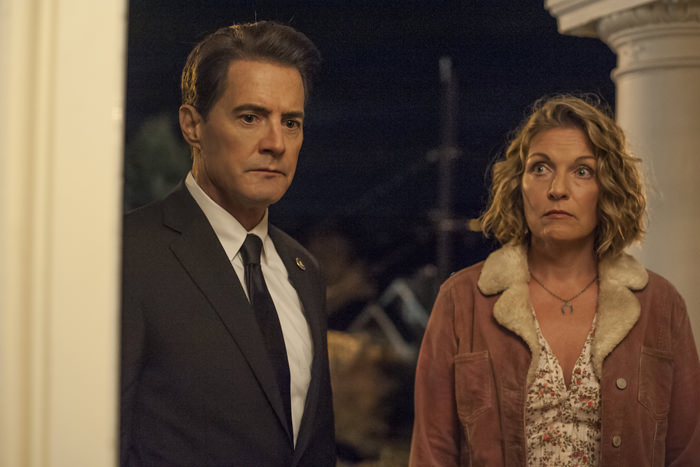
Since the near-universal reaction to the Twin Peaks: The Return finale seems to have been a collective “…the fuck?” we think it would be best for us to start off this review by recapping the ending as we saw it. We all have different takes – if any of us were even able to form “takes” at all – so in order to proceed with our thoughts, we think we should lay out what happened as we saw it. Your mileage (on lonely, dark backroads at night) may vary. In fact, we expect it to.
So:
After the graduate from the Dick Van Dyke School of Accents vanquished the BobGlob with his +10 Glove of Hulking, the OG Cooper was reunited with the OG Diane. The two of them plus Gordon Cole get magically whooshed to the Great Northern basement (source of The Great Ringing of 2014), where Coop says goodbye to them and uses his old hotel room key to walk through various dimensions, talk to giant tea kettles who used to be David Bowie and travel into the past, the night of Laura Palmer’s murder in 1989. He takes Laura’s hand and leads her away from her fate (and old Fire Walk with Me footage), thereby altering the original timeline and more or less wiping out all of the Twin Peaks story as we know it. Laura’s body never appears wrapped in plastic, Pete Martell goes happily fishing and Josie Packard can now presumably spend more time staring at herself in mirrors, deeply entranced by her own Chineseness.
But Coop loses hold of Laura’s hand, she disappears, and her screams echo throughout the empty woods. Meanwhile, Sarah Palmer – who should be living in a world where her daughter disappeared but didn’t die – smashes Laura’s homecoming portrait in rage. Time seems to loop and repeat as she does so.

Later, Coop and Diane drive 430 miles from Twin Peaks (like the Fireman told him to in the first episode, evidently), to some sort of location which allows them to “cross over,” (into a parallel dimension/alternate timeline…?) after which “everything will change.” Coop becomes less like his normal self, more dark and full of purpose. Like DoppelCooper without the Bob possession, as if the more exuberant parts of Dale Cooper were strip-mined to make the new Dougie. Diane notices her own doppelganger watching her from the parking lot of a motel they’ve pulled into. They go inside and have the most excruciating, unsexy sex you ever saw, during which Diane covers Coop’s dark, impassive face completely. There’s a sense of purpose in the sex, rather than a true emotional or physical connection; an attempt to summon something. In the morning, she’s gone, leaving a note from “Linda” addressed to “Richard” saying she doesn’t know him anymore. Coop exits the hotel (except it’s an entirely different building from the one he entered) and gets into his (entirely different) car, where he drives to Odessa, Texas. He enters a diner called “Judy’s,” goes completely hardass on a trio of good ol’ boys and scares the shit out of the employees by boiling their guns in oil. Using this non-FBI-approved method of info-gathering, he secures the address of the waitress who called in sick that day, goes to her house, knocks on the door, and Laura Palmer herself answers, except she’s middle-aged, has a southern accent, calls herself “Carrie,” and is living a life unfit for a homecoming queen. Since there’s a dead body decomposing in her living room, she opts to go with the mysterious FBI man who claims she’s someone else. They drive endless dark roads at night silently – crossing over again, apparently – until they arrive in Twin Peaks. He takes her to her childhood home but no one there is Sarah Palmer or has heard of Sarah Palmer. Coop is confused and asks what year it is. Carrie/Laura looks at the house, hears Sarah Palmer’s ghostly voice calling for her, screams that from-the-depths Laura Palmer scream, and the whole universe goes dark, as if a trap has been sprung. The end.
Just so we’re all on the same page. Or more accurately, you’re on the page we’re reading from. You may actually be on a different page altogether. That’s the beauty of Lynch’s work. It’s interpretable beyond interpretable. Of course the downside to that level of obtuseness is the risk of serious frustration on the part of the audience and endless arguing over What It All Meant. But Lynch, we imagine, doesn’t see such things as a down side to obtuseness, but rather, the hoped-for response to it.
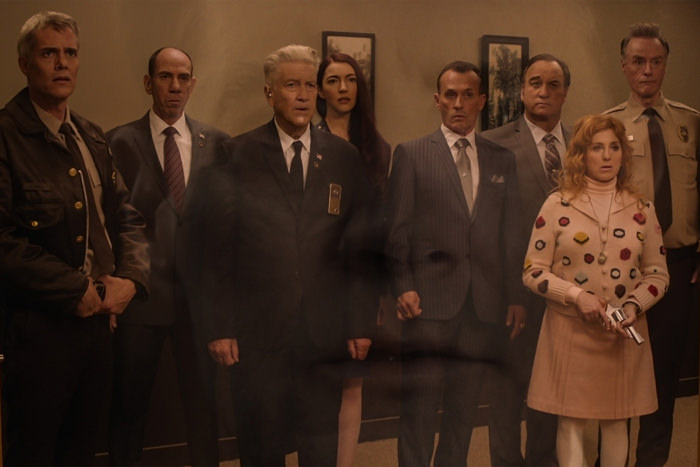
“We live inside a dream,” the superimposed face of Coop intones as he seemingly watches the story unfold along with us. Dreams almost never make any sort of linear sense and are composed mostly of symbols and imagery strung together that our waking minds seek to sort through and make sense of. Lynch told us outright what he was doing and what we should expect from it.
The idea that creators of television shows “troll” their audiences isn’t something we put a lot of weight behind. To get to the point in the production process that your vision is fully funded and your fans are eagerly waiting for your output means you have to be fairly committed to telling your story in the manner you see best. No one in that position really thinks “Let’s fuck with the audience!” Or maybe we should say no creator of any depth would. We’re trying very hard to resist the tendency to explain Lynch on his behalf, but the artist has been consistent in his approach all along. This is his vision. This is Twin Peaks. To end it in such a maddening way is not an example of a showrunner trolling his audience but an artist being true to his creation as he sees it – and as he thinks the audience understands it. If this truly is the last of a filmed Twin Peaks, then let it end on a note, line and image that will do nothing but spawn theories and endless discussion for the next quarter century. How could Twin Peaks end in any other way? How could we expect Lynch to end it otherwise? As we noted in a previous review, for a quarter century, Twin Peaks has been a pop culture artifact defined by its obtuseness and lack of closure. All Twin Peaks: the Return did was replace “How’s Annie?” with “What year is this?”
And we should note that, after an 18-hour followup to that first question, Lynch and Frost didn’t lift a finger to answer it. How’s Annie? We’ll never know. What year is this? Ditto. Twin Peaks wasn’t “explained” with this series. The story wasn’t closed; there was no landing to stick. Instead, the story was deepened, enhanced, and enlarged far beyond the boundaries of a homecoming queen’s death in a small town in 1989. What we’re left with now is so much more than what we were left with when the original series ended. If nothing else, Twin Peaks: The Return re-contextualized Fire Walk With Me as an essential chapter bridging the two series instead of a weird outlier that was hard to watch. But there is almost certainly never going to be a Twin Peaks: The Final Chapter after this season and Lynch almost certainly knew this.
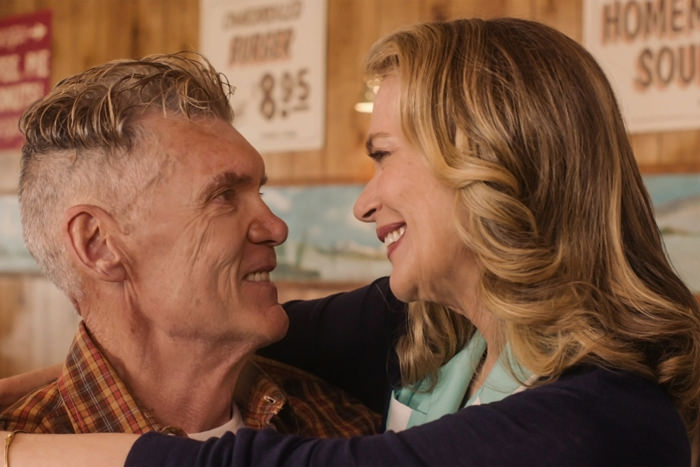
Lynch and Frost were not cruel about this. We got to know the lives of Shelley, Bobby, Dr. Jacoby, Sarah Palmer, Nadine, Lucy and Andy fairly well. We got to see Ed and Norma’s happy ending. We got bare-bones glimpses of James and Audrey that underlined in bright red the idea that the Sexpots and Bad Boys of your youth age and decay like everyone else. We got the sense that, while Twin Peaks: The Return had shifted cleanly away from its melodramatic, small-town network drama origins into a much darker exploration of evil and decay spread out across America, the stories of its original players (and several barely explained newcomers) were running in the background, like a soap opera that’s been on the air for a quarter-century. In other words, the original version of Twin Peaks had become Invitation to Love (the daytime soap everyone in Twin Peaks watched in 1989) while this rawer, darker, more primal version of it was free to go its own way.
We also got explanations (as much as L&F were willing to, anyway) of some of the series’ biggest mysteries and unanswered questions. Chet Desmond. Diane Evans. The Giant. The Lodge. The beginning and end of Bob. Judy. And in the end, we got something we didn’t have the nerve to ask for: Laura Palmer, alive. This was Lynch taking nostalgia to its furthest and most absurd end. If you ask to return to Twin Peaks, a place of mystery, magic, and dimensional doorways seemingly every few feet, you’re risking the whole thing getting swept away from you. You got your return, viewer. You went so far back into nostalgia that you accidentally erased the whole thing, leaving a weirder, unexplained universe in its stead. This is very much of a piece with the most persistent themes of The Return: The world is full of decline and decay, but indulging in nostalgia is at best a pointless exercise and at worst, a dangerous one. What makes Twin Peaks: The Return a masterpiece of television is how Lynch and Frost leaned so hard into the very reasons anyone would want to see another season of Twin Peaks – and then showed how that very wanting was flawed and incapable of giving the audience satisfaction. It was a tale about aging and the pointlessness of nostalgia, told by the very people best suited to tell it: the elderly. Lynch never once shied away from the inescapable fact that everyone you want to see from Twin Peaks, as well as everyone you trust to tell you how they’re doing, got old. We can’t recall a television show so committed to ensuring that every line, wrinkle and darkened tooth of its stars got photographed with as much detail as possible. We also can’t recall a show so committed to depicting dementia and loss of mental faculties in such excruciating detail. As we said in our previous essay on the series:
“This is not the ‘Thank you for being a friend’ version of aging. It’s a world of sadness, decline and degradation. This is a world where old men sell their blood to buy food and even older men spot them a fifty to keep them healthy for another week. A world where grandmothers get robbed by their grandsons. This is a world where the blasted landscape of Sarah Palmer’s mind is randomly available for viewing by any passerby. Where the Log Lady is wasting away while she whispers her last mysteries. Where Dr. Jacoby is a ranting lunatic and Harry Truman is dying somewhere far away. This is a world where Big Ed sits alone, eating his soup and watching the same car drive by, over and over again.”
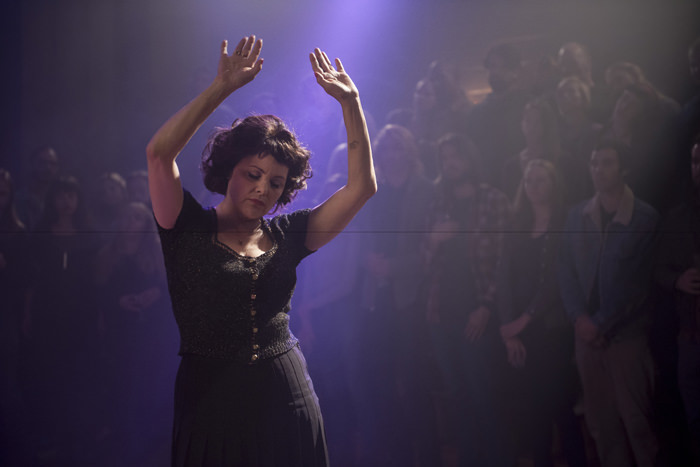
As many an old person will tell you, getting old ain’t pretty. And as the wise ones will tell you, there’s no use worrying about what’s done. These ideas are so basic as to be cliches and yet you’ll rarely see so much time, money, effort and sensitivity put into portraying them as major themes of a prestige television drama. It may not be the AARP-approved idea of the state of being old, but that doesn’t make Lynch and Frost’s efforts here any less poignant.
We didn’t get answers and we didn’t get closure. What we got was a purely Lynchian world of diner waitresses and motels and dark country roads at night. Of drugs and murder and abuse. Of pie and coffee and life-long love affairs. Of prostitution and gangsters and hitmen. Of fathers and sons. Of mothers and daughters. Of insanity and depression. Of demons and angels. Of quirkiness, local characters, and self-expression. Of sadness. Of despair. Of the deep, lush woods and the blinding, blasted desert. Of showgirls and receptionists and exasperated wives. Of randy old men leering at women’s asses. Of virtually no people of color. Of rape and addiction and poverty. Of death, of death, always and forever, full of death.
Do we want a new season? Not at all. This ending is so pure, so perfect. It’s dark, bleak, and maddeningly obtuse. Utterly Twin Peaks.
The post Twin Peaks: We Live Inside a Dream appeared first on Tom + Lorenzo.

